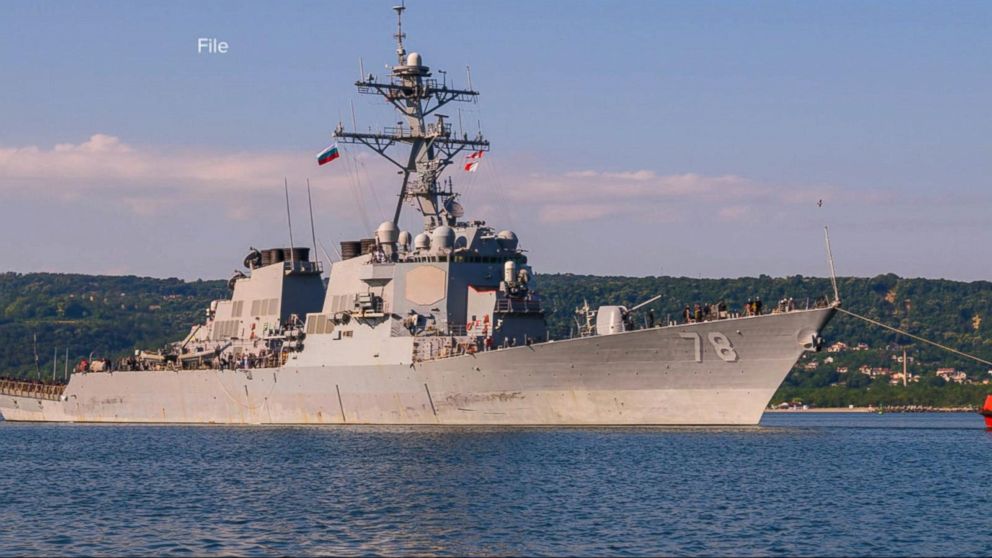Russian aircraft buzzed US Navy ship 3 times in a day
— -- Russia has secretly deployed a new cruise missile in the country, a move a U.S. official labels an apparent violation of the Intermediate Range Nuclear Forces (INF) Treaty signed in 1987.
The move is one of several incidents involving the Russian military and the United States that came to light on Tuesday. The Pentagon said that Russian planes flew low and fast above an American destroyer in the Black Sea last week in an "unsafe and unprofessional" manner and that a Russian intelligence vessel was detected heading north along the East Coast of the United States.
Known by American officials as the SSC-8, the cruise missile has been in development for years and was most recently tested in 2014.
The Obama administration hoped that Russia would not place the missile in operational status — a violation the INF Treaty, which bans American and Russian intermediate-range missiles based on land.
But according to a U.S. official, Russia now has two battalions of the cruise missile. One is at a test location at Kapustin Yar, a Russian rocket launch and development site near Volgograd. The other was moved in December to another military location in Russia.
"The Russian Federation remains in violation of its INF Treaty obligations," said Pentagon spokeswoman Lt. Col. Michelle Baldanza in a statement.
State Department spokesman Mark Toner said in a statement, "As detailed most recently in the 2016 compliance report, the Russian Federation remains in violation of its INF Treaty obligations not to possess, produce or flight-test a ground-launched cruise missile with a range capability of 500 to 5,500 kilometers or to possess or produce launchers of such missiles."
"We have made very clear our concerns about Russia's violation, the risks it poses to European and Asian security and our strong interest in Russia returning to compliance with the treaty," said Toner. "The administration is undertaking an extensive review of Russia’s ongoing INF Treaty violation in order to assess the potential security implications for the United States and its allies and partners."
The missile's deployment and operational status was first reported by The New York Times.
Meanwhile, it appears Russia has resumed unusually close interactions with American military vessels in international waters.
On Feb. 10 the Navy destroyer USS Porter noted three "unsafe and unprofessional" encounters with Russian military aircraft while in the Black Sea. In each of the incidents Russian aircraft approached the destroyer at an unspecified "low altitude," and some were at "high speed," according to the Pentagon.
The Russian aircraft did not have their transponders on and did not respond when the destroyer's crew hailed the planes on radio.
"Such incidents are concerning because they can result in accident or miscalculation," said Baldanza.
Russia's Defense Ministry denied any incidents occurred on Feb. 10 between Russian aircraft and the Porter. "All flights of our aircraft are done and have been done in neutral waters of the Black Sea in accordance with the international rights and security demands," said Igor Konashenkov, a Defense Ministry spokesman.
Last April, Russian fighter jets repeatedly buzzed an American destroyer in the Baltic Sea, with one coming as close as 30 feet to the USS Donald Cook. That incident was one of several close encounters between the U.S. and Russian militaries in 2016, but officials said recently that such encounters had become infrequent.
At the time of the Porter incident, Baldanza said, the destroyer was "conducting routine maritime operations in international waters in the Black Sea following the conclusion of Exercise Sea Shield."
According to her, the first encounter involved a Russian Ilyushin 38, a maritime patrol and anti-submarine aircraft. The plane "flew in an unsafe and unprofessional manner due to the unusually low altitude" above the Porter.
The second incident involved two SU-24 fighters and the third a different Su-24. A U.S. official said one of the fighters flew 300 feet above the Porter.
Meanwhile, American officials are not expressing concern about the presence of a Russian intelligence-gathering ship headed north along the East Coast. The White House referred questions on this issue to the Defense Department.
According to a U.S. official, the Russian intelligence vessel Viktor Leonov was 70 miles off the coast of Delaware yesterday in international waters, heading in a northerly direction. American territorial waters extend 12 miles from shore.
The official said the speculation is that the Russian ship is headed near the U.S. Navy's submarine base at New London, Connecticut.
Soviet military monitoring of U.S. sub bases took place frequently during the Cold War but became infrequent after the fall of the USSR.
In 2015 a Russian spy ship made its way south along the East Coast past the sub base at Kings Bay, Georgia, apparently mapping underwater communications cables off the Florida coast.
If the Leonov follows previous deployment patterns, it will eventually head to south to Cuba.
The U.S. official said there is not much concern about the Leonov's movements or its intelligence-gathering capabilities.
The Russian ship was in the mid-Atlantic a month ago and made a stop in Kingston, Jamaica, in early February.




